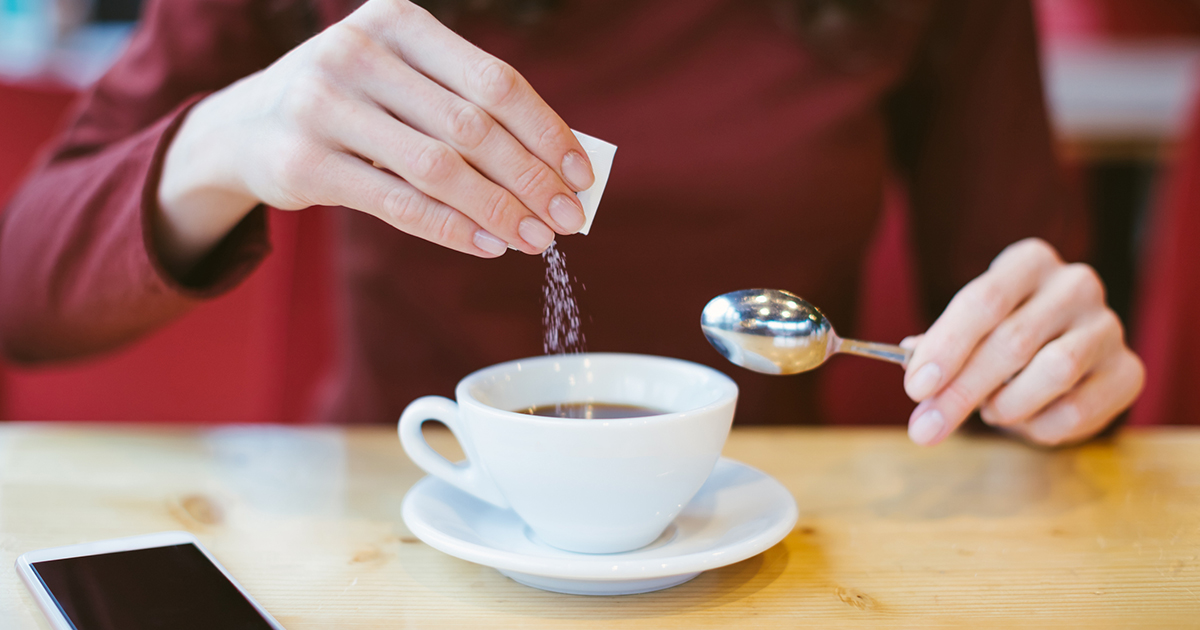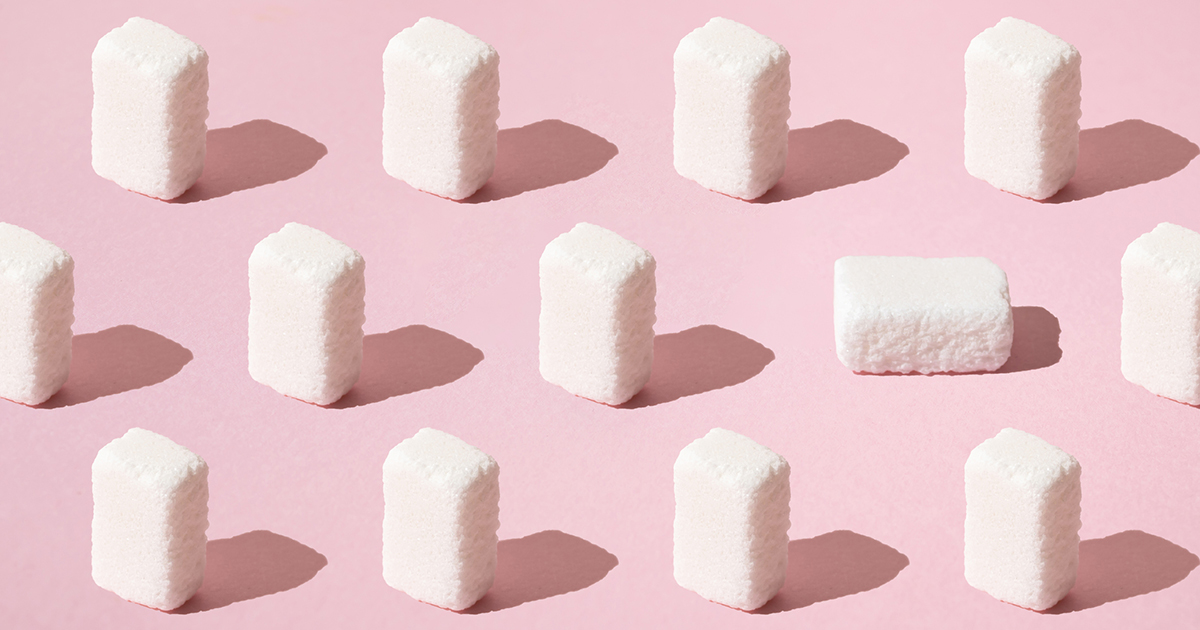Artificial sweeteners can seem like a miracle product for those with a “sweet tooth” who encounter a need to switch to a reduced-sugar diet. As our bodies grow and age, many of us find an occasion to reduce our sugar consumption or overall calorie intake. This change can be founded on personal health goals or mandated by a medical necessity, such as in the preventative treatment of pre-diabetes symptoms.
Is Sugar Free Healthy?
A reduced-sugar diet might be a temporary response to a health concern or a lifelong change to help manage a chronic issue. The longer your sugar-free diet lasts, the more likely it is that you’ll want to seek out viable replacements for some of your old, sugary favorites.
Sugar Is Everywhere
People who attempt to switch to a sugar-free diet are often dismayed to notice that sugar pops up in more places than they had anticipated. For instance, we all know that soft drinks, candies, and donuts are packed with sugar. A single 12-ounce can of name brand cola contains between 150 and 200 calories on average, with basically all of them coming from the sugar content.
Cutting out sugary candy and drinks can be one of the easiest and most obvious ways to set yourself on a sugar-free path, but it’s not quite as simple as that. Depending on the alternative chosen, you may find yourself asking: is sugar free really sugar free? Sugar, and its not-so-sneaky aliases, such as high-fructose corn syrup, are found in many other foods, and they don’t all taste so sweet:
-
Ketchup, Salad Dressings, Barbecue Sauces
A single tablespoon of plain ketchup contains nearly 4 grams of sugar, which is more than a quarter of the total sugar in an Oreo cookie.
-
Bread, Pizza Crust, and Other Baked Goods
Some of the most common American breads and buns would be considered cake in other countries. For those with the time and energy, learning to bake your own reduced sugar bread can be a rewarding part of undertaking a low sugar lifestyle.
-
Fresh Fruits
While consuming fresh fruits is typically a healthy choice, natural sugar is still sugar, which means fruit can contribute to sugar-related health issues just the same as high fructose corn syrup. Fruit juices, even naturally derived ones, are worse yet because they concentrate all of a whole fruit’s sugar and calories while discarding the healthy fiber.
-
Beer, Wine, and Liquor
Alcohol’s fermentation process is dependent on sugars being present, so even though your favorite adult beverage may be rather unsweet by the time it reaches your glass, the caloric content remains. In fact, even if you were to drink straight liquor with no actual sugar content, the converted sugars and starches that make up alcohol still have a caloric content of 7 calories per gram,[1]NHS. (2020, January 13). Calories in alcohol. NHS choices. Retrieved April 3, 2022, from https://www.nhs.uk/live-well/alcohol-advice/calories-in-alcohol/ which is comparable to that of pure fat. Many favorite liqueurs and mixers are also extremely high in sugar.
-
Honey, Syrup, Molasses
While using honey, maple syrup, or pure cane syrup as a sugar alternative seems like a healthier choice, these are not actually sugar substitutes at all. Products made with “real” cane sugar offer few tangible benefits over those sweetened with the addition of corn syrup. Meanwhile honey and refined tree sap are still just other forms of sugar at the end of the day, and their impact on your caloric intake and blood glucose levels aren’t much changed just because the sugar in this case has been naturally processed by way of trees or bees.
With the exception of fresh fruits, the above items can be readily found in low-sugar or reduced-calorie varieties. These alternatives often use high carbohydrate or fat content in an effort to reformulate the texture or flavor of the product to make up for the missing sugar, which can sometimes make them just as unhealthy as their sugared counterparts. Many other sugar-free products rely on sweetening agents that must be produced in a lab and added to products artificially, which is an automatic turn off to some health-conscious consumers.
This all begs the question: is sugar free actually healthy? As with many other health and nutrition questions that seem simple on the surface, the answer is far more complex than a simple ‘yes’ or ‘no.’ Whether a sugar-free diet works or not will depend on your unique body, your individual health goals, and what sorts of foods you’re eating in place of the sugary things you’ve eliminated.
Is Sugar Free Better Than Sugar?

In the scientific and medical communities, artificial sugar substitutes are sometimes referred to as “nonnutritive sweeteners.” This term refers to the fact they add sweetness to a food’s flavor profile but have no nutritional value, which is to say they contain no calories and no essential nutrients.
There are many zero calorie and low-calorie artificial sweeteners on the market today, and not all of them are created equal. So, is sugar free actually healthy? Is sugar free better than sugar in any measurable way; is sugar free worse than sugar? And, once you get past the zero-calorie hype, is sugar free good for weight loss at all? The answers to each of these questions will depend on which specific non-nutritive sweetener is being used to replace sugar.
In general, swapping out sugar for any artificial zero calorie sweetener will indeed offer results in terms of reducing your overall caloric intake and managing high blood sugar. This can be an effective part of overall weight management, reducing your risk of diabetes, heart disease, and other issues. However, each one of these different nonnutritive sweetening agents will have its own effects on your body, just like any other food or chemical you choose to consume.
In the United States, the Food and Drug Administration (FDA) has approved five different artificial sweetening agents. These products are as follows:
1. Saccharin
One of the most well-established artificial sweeteners, saccharin has been in use for over a hundred years and has been the subject of a great deal of research over that century. You may know it as the brand name product Sweet N’ Low. Saccharin is promising as a sweetening agent because it has zero calories, doesn’t affect blood sugar, and is several hundred times sweeter than sugar, meaning a small amount goes a long way.
The research behind saccharin has not always been positive, however. A 1977 study correlated saccharin ingestion with the development of bladder tumors in male rats.[2]Price, J. M., Biava, C. G., Oser, B. L., Vogin, E. E., Steinfeld, J., & Ley, H. L. (1970). Bladder tumors in rats fed cyclohexylamine or high doses of a mixture of cyclamate and saccharin. … Continue reading Thankfully, over 30 ensuing studies have determined that this issue does not affect humans.[3]Ellwein, L. B., & Cohen, S. M. (1990). The health risks of saccharin revisited. Critical reviews in toxicology, 20(5), 311-326. https://www.tandfonline.com/doi/abs/10.3109/10408449009089867
2. Acesulfame Potassium
Much like saccharin, “Ace K” is hundreds of times sweeter than natural sugar and has dozens of studies backing its FDA approval. Other studies, however, have demonstrated acesulfame’s potential to disrupt gut health and actually increase weight gain in mice.[4]Bian, X., Chi, L., Gao, B., Tu, P., Ru, H., & Lu, K. (2017). The artificial sweetener acesulfame potassium affects the gut microbiome and body weight gain in CD-1 mice. PloS one, 12(6), e0178426. … Continue reading This issue has not been replicated in human studies but remains a potential concern.
3. Aspartame
One of the most widely-used artificial sweeteners is also one of the most controversial. Aspartame has been used for a long time, particularly in diet soft drinks, but is marred by a lot of anecdotal tales and online posts linking it to cancer and mental health disorders.
It has been approved for use as a sweetener in over 100 countries, however, and even multinational watchdog agencies have determined that aspartame is generally safe for consumption. One notable exception: people suffering phenylketonuria, a medical condition that can be seriously exacerbated by aspartame.
4. Neotame
Neotame is an N-alkyl derivative similar to aspartame in structure.[5]Witt, J. (1999). Discovery and development of neotame. World Rev Nutr Diet, 85, 52-57. … Continue reading While chemically similar, neotame is 30 to 60 times sweeter than aspartame – and around 10,000 times the sweetness of standard table sugar. This makes neotame great for applications where sweetness needs to be achieved with an extremely small amount of additive.
5. Sucralose
Sucralose is relatively new among nonnutritive sweeteners, having only been approved for widespread use as a sweetener in the late 90s. Sucralose is unique in the fact that it is derived from sugar itself. This has been played up as a marketing gimmick to make sucralose sound more “natural” than other sugar alternatives, but it is deceptive at best.
While sugar may be involved in the creation of sucralose, it is actually believed to have been discovered while researchers were attempting to develop new insecticides. You have probably seen or consumed sucralose under the brand name Splenda. It is considered fairly safe for consumption, however it does contain small amounts of toxic chlorine, which may be concerning to some.
6. Stevia
In addition to these five artificial, nonnutritive sweetening agents, the FDA has also approved the use of a sweetening agent called stevia. Stevia is different from nonnutritive sweeteners, and arguably closer to sugar because it is also a naturally occurring substance. Stevia is derived from a plant of the same name and is about 200 times sweeter than standard sugar. While it is not entirely devoid of calories, it can be used effectively in very small amounts, effectively allowing it to compete with zero-calorie sweeteners.
Is Sugar Free OK for Diabetics?
The management of diabetes and related conditions is an extremely common use for sugar-free foods and artificial sweeteners. Artificial sweeteners can allow someone with a serious blood sugar condition to continue enjoying some of the flavors they love. Some people, however, still cling to anecdotal evidence and conspiracy-like rumors about artificial sweeteners actually being bad for diabetics. A 2018 review of available studies was not able to conclude any scientifically demonstrable link between artificial sweeteners and the worsening of diabetes or its symptoms.[6]Sanyaolu, A., Marinkovic, A., Gosse, J., Likaj, L., Ayodele, O., Okorie, C., & Verner, O. (2019). Artificial sweeteners and their association with Diabetes: A review. J Pub Health Catalog, 1(4), … Continue reading
While other research exists which shows people who drink a large number of diet soft drinks may be at higher risk for obesity, heart disease, and Type 2 Diabetes, it now seems likely that these links have more to do with people who consume greater amounts food and beverage in general, rather than showing a specific connection between diabetes and artificial sweeteners. It is possible that a psychological effect is at play: people who consume lots of sweet but low- or zero-calorie drinks may stop associating sweetness with caloric intake and therefore start consuming other sugary foods less thoughtfully.
Adopting a Sugar-Free Diet

If you do need to cut sugar from your diet, it is important to keep in mind that these artificial sweeteners are relatively new additions to the human diet. None of these products has been consumed by humans for very long, so their full influence on human health is not yet known. We can only hope that further research will continue to shed light on what measures, if any, should be taken to regulate artificial sweeteners and bring the public healthier sugar-free options.

Kristina Calligan is a sub-specialty nurse practitioner in Women’s Health. A native to Arizona she obtained her Bachelor of Science in nursing in 2006 at Grand Canyon University in Glendale, Arizona. Never one to stop striving and achieving all that she could, she completed two master degrees in Nursing Science and Business Administration in 2012. Ms. Calligan joined Arizona Gynecology Consultants in 2009. Prior to working at Arizona Gynecology Consultants, she worked as a nurse in labor and delivery at several local hospitals and a research coordinator in women’s health care.
References
| ↑1 | NHS. (2020, January 13). Calories in alcohol. NHS choices. Retrieved April 3, 2022, from https://www.nhs.uk/live-well/alcohol-advice/calories-in-alcohol/ |
|---|---|
| ↑2 | Price, J. M., Biava, C. G., Oser, B. L., Vogin, E. E., Steinfeld, J., & Ley, H. L. (1970). Bladder tumors in rats fed cyclohexylamine or high doses of a mixture of cyclamate and saccharin. Science, 167(3921), 1131-1132. https://www.science.org/doi/abs/10.1126/science.167.3921.1131 |
| ↑3 | Ellwein, L. B., & Cohen, S. M. (1990). The health risks of saccharin revisited. Critical reviews in toxicology, 20(5), 311-326. https://www.tandfonline.com/doi/abs/10.3109/10408449009089867 |
| ↑4 | Bian, X., Chi, L., Gao, B., Tu, P., Ru, H., & Lu, K. (2017). The artificial sweetener acesulfame potassium affects the gut microbiome and body weight gain in CD-1 mice. PloS one, 12(6), e0178426. https://journals.plos.org/plosone/article?id=10.1371/journal.pone.0178426 |
| ↑5 | Witt, J. (1999). Discovery and development of neotame. World Rev Nutr Diet, 85, 52-57. https://books.google.com/books?hl=en&lr=&id=ifgKL_7e1fMC&oi=fnd&pg=PA52&dq=neotame&ots=cs3dxsTPXS&sig=ZrNk9Zv5Vb1WK7hUzipRjeMTk1M#v=onepage&q=neotame&f=false |
| ↑6 | Sanyaolu, A., Marinkovic, A., Gosse, J., Likaj, L., Ayodele, O., Okorie, C., & Verner, O. (2019). Artificial sweeteners and their association with Diabetes: A review. J Pub Health Catalog, 1(4), 1-3. https://www.researchgate.net/profile/Adekunle-Sanyaolu/publication/329328224_Artificial_sweeteners_and_their_association_with_Diabetes_A_review/links/5c316cd5a6fdccd6b59630b9/Artificial-sweeteners-and-their-association-with-Diabetes-A-review.pdf |


